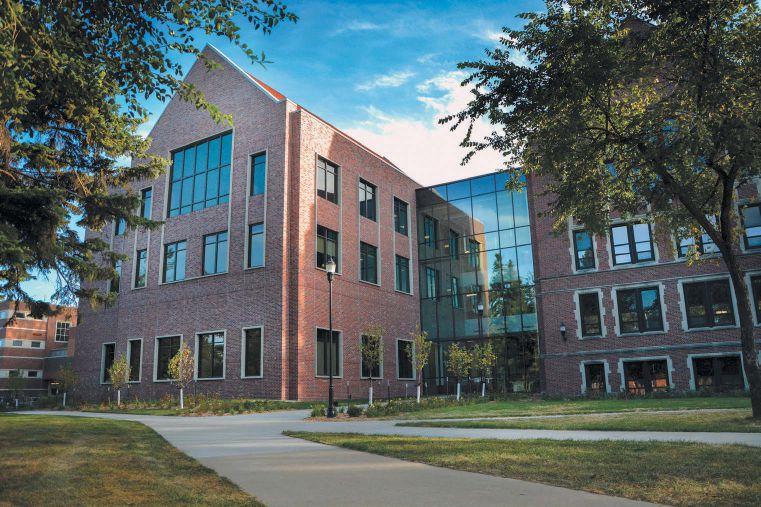
3 minute read
INSIGHTs & INTUITION Q.
What key changes or trends in workforce training would you like Prairie Business readers to know about?

Wood Director of College Relations Lake Region State College Devils Lake, N.D.
At Lake Region State College, an increasing number of students are seeking certificates in programs such as Wind Energy Technology. Students are recruited while enrolled at LRSC and join the workforce immediately upon certificate completion, likely finishing a degree or further credential online.
We also are developing non-traditional apprenticeship opportunities for programs, specifically Information Technology and Simulator Technology. Students will be hired and sponsored by an employer, complete related classroom instruction with LRSC and have on-the-job worksite training. After two years, the registered apprenticeship is completed, an AAS degree has been earned, and a full-time job is waiting.
One important trend is that the North Dakota Legislature has followed through on its verbal commitments and provided significant funding for workforce training. This funding is key to continuing to strengthen North Dakota’s future workforce.
Other trends include a shift toward more technical training and a new focus on leadership training. The need for highly skilled workers continues to grow, and industries are not only responding but also ensuring the next generation of leaders is prepared.
Last but not least, many companies are moving to improve safety in the workplace by focusing on individual decision-making processes. This empowerment and education of all workers to make safe choices is exciting.
Regional director of technical programs and training, TrainND Northwest Williston State College Williston, N.D.
In its efforts to help fill the skills gap and talent shortage, Lake Area Technical Institute in Watertown, S.D., has implemented Registered Apprenticeships, a workforce strategy that is now being offered to business and industry.
Registered Apprenticeships are a time-tested, “earn while you learn” approach that combines on-the-job training, training-related instruction online or in the classroom, mentorship and incremental wage increases.
The result is a win-win for all, as employers attain a well-trained and educated workforce, while the student apprentices earn nationally recognized credentials (or in some cases diplomas or associate’s degrees) along with valuable on-the-job training, a combination leading to great careers.
At Northland, we see the national trend toward short-term certificate programs and competency-based education being reflected in our own programs.
For example, in the past couple of years, many of our two-year degree programs have adopted one- to two-semester certificates that stack into the full program. This ensures that students can earn work-ready credentials while still being able to easily advance their educational training.
This trend at Northland is in part the result of our tight labor market, where industry and workforce demand a quick route to employment.
Brian Huschle Provost
Northland Community & Technical College East Grand Forks and Thief River Falls, Minn.
John Richman President
North Dakota State College of Science Wahpeton, N.D.
Today’s businesses are more active in workforce development than ever before. Rather than waiting for graduates to show up at their doorsteps, industry partners are helping to prepare students to be knowledgeable workers of the future.
Industry partnerships with higher education institutions provide valuable educational opportunities, making it possible for students to learn on the latest equipment, tools and technology. Many businesses and economic development organizations have also begun student sponsorship programs as a successful way of recruiting and retaining employees.
These initiatives are helping to create high-paying career opportunities for students, while reducing their cost of education. This trend is also giving businesses a head start on the recruitment process and more direct access to graduates who can immediately make a difference in their companies.
Today’s regional workforce shortage can force businesses and industries to hire workers who lack a complete skillset, but M State’s Workforce Development Solutions can custom design the skills and technology training that employers and employees need. Workforce Development Solutions can address a workforce’s skills gaps through training offered on-site, on campus, online or in mobile units.
By partnering with businesses, we customize skills training and can bring our trainers and equipment – including our mobile training trailers – right to the worksite for hands-on training.
M State can provide the training that employers and employees need when they need it.
G.L. Tucker Executive Director
Workforce Development Solutions Minnesota State Community and Technical College Detroit Lakes, Minn.
The April reading for the Mid-American economy marks THE 29TH STRAIGHT MONTH the index has remained above growth neutral 50.0, Creighton University reports.
“The regional economy continues to expand at a positive pace. However, as in recent months, finding and hiring qualified workers remained the chief threat to manufacturing economy for the region.
“Approximately 44.7 percent identified labor shortages as the greatest threat to company success in the next 12 months,” said Ernie Goss,director of Creighton University’s Economic Forecasting Group.
Source: Creighton University













